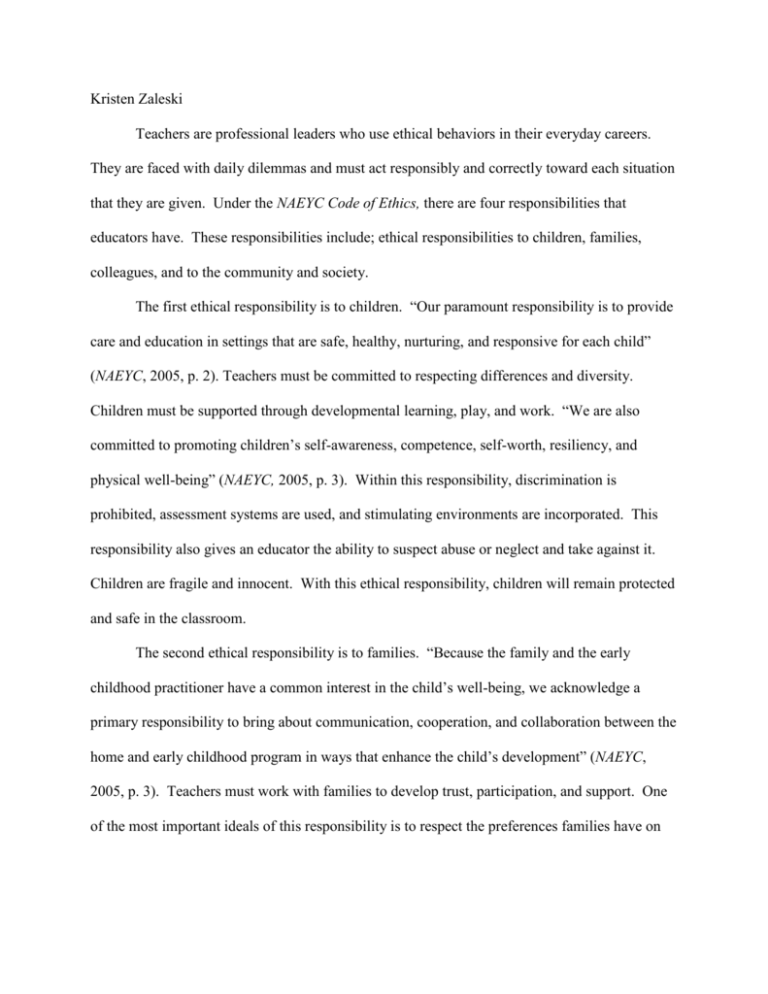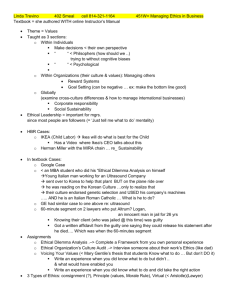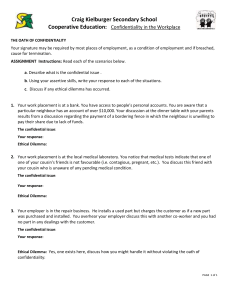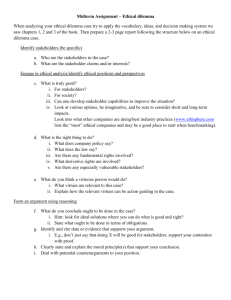File
advertisement

Kristen Zaleski Teachers are professional leaders who use ethical behaviors in their everyday careers. They are faced with daily dilemmas and must act responsibly and correctly toward each situation that they are given. Under the NAEYC Code of Ethics, there are four responsibilities that educators have. These responsibilities include; ethical responsibilities to children, families, colleagues, and to the community and society. The first ethical responsibility is to children. “Our paramount responsibility is to provide care and education in settings that are safe, healthy, nurturing, and responsive for each child” (NAEYC, 2005, p. 2). Teachers must be committed to respecting differences and diversity. Children must be supported through developmental learning, play, and work. “We are also committed to promoting children’s self-awareness, competence, self-worth, resiliency, and physical well-being” (NAEYC, 2005, p. 3). Within this responsibility, discrimination is prohibited, assessment systems are used, and stimulating environments are incorporated. This responsibility also gives an educator the ability to suspect abuse or neglect and take against it. Children are fragile and innocent. With this ethical responsibility, children will remain protected and safe in the classroom. The second ethical responsibility is to families. “Because the family and the early childhood practitioner have a common interest in the child’s well-being, we acknowledge a primary responsibility to bring about communication, cooperation, and collaboration between the home and early childhood program in ways that enhance the child’s development” (NAEYC, 2005, p. 3). Teachers must work with families to develop trust, participation, and support. One of the most important ideals of this responsibility is to respect the preferences families have on culture, language, customs, and beliefs. Families play a large part in the development of children, so their relationship with educators must be strong. The third ethical responsibility is to colleagues. “In a caring, cooperative workplace, human dignity is respected, professional satisfaction is promoted, and positive relationships are developed and sustained” (NAEYC, 2005, p. 5). Having strong relationships with colleagues not only creates an enjoyable environment to work in, but also a supportive one. Within this responsibility, teachers share resources to ensure the best possible care, they support professional development, and recognize personal achievement. “Based upon our core values, our primary responsibility to colleagues is to establish and maintain settings and relationships that support productive work and meet professional needs” (NAEYC, 2005, p. 5). The ethical ideals for colleagues are just as important as the ideals for children and families. A supportive and safe work environment allows teachers to focus on improvement and self-development. The last ethical responsibility is to the community and society. “Our responsibilities to the community are to provide programs that meet the diverse needs of families, to cooperate with agencies and professions that share the responsibility for children, to assist families in gaining access to those agencies and allied professionals, and to assist in the development of community programs that are needed but not currently available” (NAEYC, 2005, p. 6). This responsibility has an ideal of working as a team to provide all children with food, shelter, and healthcare. Children and families must also be kept free from violence in their community. As a collective society, educators can fix violating programs, safety concerns, and extend services to those in need. The four reasons for the a code of ethics include; power and status of practitioners and that children are vulnerable; multiple client groups including parents, children, centers, specialists, and community agencies; local and state regulation; and rule and ambiguity. A code of ethics is important because it is rooted through the history of education. The code of ethics allow educators to effectively help children develop, create a strong community, respect citizens, respect diversity, and develop trust and respect. Ethics are the moral choices of right and wrong. As a teacher, it is very important to be professional and keep information confidential. Without a code of ethics, there would be no privacy or trust within the community. This would create chaos and ultimately lead to the suffering of the children. I fully support the NAEYC Code of Ethics. As a teacher, trust is one of the most important values in the classroom. Without the four responsibilities discussed, there would be no support, safety, warmth, or care in the educational environment. The NAEYC Code of Ethics stands as a commitment to the moral obligations of childcare. This is so important to educators because of the respect and appreciation that colleagues, families, and communities all deserve. Ethical Dilemmas The developmental setting of this dilemma was in the toddler group (ages 2 and 3). This ethical dilemma deals with the families of children who continue to resort to biting as a form of expression. When a situation involving biting came up in the classroom, a set of parents were very concerned and would ask questions outside of work about it. There was one dilemma where both children involved in a disputed resorted to biting each other. When children resort to biting, a call home must be made. During this incident, the parents of the two children worked in the same department of the hospital. “As a professional, it was my job to contact the parents immediately to inform them of the biting that took place. After calling the first parent at work, I had to hang up the phone and call the same department back to speak with the other parent. I was asked by each parent which child bit the other first. As a professional, I had to keep this information confidential. Many parents tend to label the children that bite. This can cause isolation and bullying, which is not fair for the child. It was my ethical responsibility to keep the specific details confidential to protect the children. This was an ethical dilemma because I was asked to share information that could harm the children or expose them as a labeled biter. I also had to involve the families of the children in the matter.” This dilemma was an ethical responsibility to families. Ideal I-2.8 is, “To help family members enhance their understanding of their children and support the continuing development of their skills as parents” (NAEYC, 2005, p. 4). This ideal fit with dilemma because of the need to involve the families in the matter. It is very important to inform family members of developmental strengths and weaknesses. By calling the parents of each child involved, the cooperating teacher was helping the families understand their children and how they, as parents, can help ease the situation. The principle of this dilemma was P-2.9. This principle states that, “We shall inform the family of injuries and incidents involving their child of risks such as exposures to communicable disease that might result in infection, and of occurrences that might result in emotional stress” (NAEYC, 2005, p. 4). The teacher was morally obligated to take action because biting can affect the well-being of children and disturb safety measure in the classroom. It was also her ethical responsibility to inform each family of the biting that occurred. There was no side taking and names were kept confidential, but the purpose of explaining the incident to the families was completed. There is an incident report that is filled out and signed by the teacher and center administrator for parents to look over. This dilemma was solved with informing both parents, but keeping details confidential to protect the children. Parents were informed to raise awareness and take measures into helping the children stray away from biting. The code of ethics would suggest that the child is protected at all times. Each child is to be respected and supported. By informing the families, they become aware of the situation and are fully supportive of the steps that must be taken to prevent another biting occurrence. The second dilemma involves working with colleagues in a toddler developmental setting. When interviewing the teacher, she stated, “The hardest part I find working with a lot of different people is the different teaching styles. Our center is really about the freedom of style for each classroom. This sometimes poses problems for the shared spaces.” In the morning for 2 hours, the toddler room is joined with the pre-toddler room as free play. This not only joins rooms, but also teachers. She continues to say, “on the playground for instance, one set of teachers may allow the children to climb up the slide while the other would prefer them not to. Finding the balance so that both sets of teachers are happy and feel as though the children are safe in the playground environment can be challenging. Sometimes you work more smoothly with some teachers than others, often because the teaching styles are more similar. Finding a way to work as one ‘toddler team’ can also be a challenge. We find that trusting that everyone is doing what is best for children and keeping up with communication causes a lot less stress for anyone involved.” This is an ethical dilemma because colleagues often disagree on teaching styles. The dilemma mentioned about slide rules is very common. There must be some sort of agreement to keep the peace between colleagues. The ideal in this ethical dilemma is 1-3A.1. This is, “To establish and maintain relationships of respect, trust, confidentiality, collaboration, and cooperation with co-workers” (NAEYC, 2005, p. 5). The principle of this dilemma is P-3C.1. This principle states that, “In decisions concerning children and programs, we shall draw upon the education, training, experience, and expertise of staff members” (NAEYC, 2005, p. 6). The important moral obligation in this situation is to meet with members as a team to set collaborative rules and regulations while working together. This dilemma in particular was handled in a way that when children we not on the top of the slide, then they could climb it. If children were on the top of the slide, they could only slide down it. All colleagues could incorporate their teaching styles in a way they made everyone happy. The Code of Ethics would most likely suggest that educators discuss ideas or knowledge about teaching styles to work out what fits best in the classroom. This is a developmentally appropriate practice. Closing Summary The resolutions of the ethical dilemmas that were discussed directly connects to my personal ethical beliefs. I believe in keeping information confidential when it does not need to be shared. I also believe in protecting, nurturing, and providing a safe environment for children. Working with colleagues is also a very important ethical belief to me. With full support from coworkers, the educational atmosphere is less stressful. There seems to be more agreement and less quarrels over which teaching strategy is “right.” By sitting down and to discuss teaching styles, there is a collaborative effort involves that creates the best environment possible without stepping on any toes. The most important ethical belief is to support the children. Under no circumstance would I expose a child as a label for other parents to use for them. The idea of a child being isolated and bullied in the classroom is a worst nightmare of mine. The resolution of each dilemma relates to my belief in confidentiality and collaboration with other educators. These moral obligations are necessary for the overall success of the educational environment. My personal code of ethics comes from personal experiences and family background. Growing up, I was raised to accept everyone around me. I was taught to refrain from discriminating and learn to understand people for who they are on the inside. To this day, I keep my family lessons close to my heart. I find that it is so important to have an open mind to all those around me. In the classroom, this is an ethical belief as well as a personal belief. I also had an experience of a student of mine with ADHD being labeled by parents as the wild one. I find labeling to be extremely disrespectful to not only the child, but also the family. As an ethical belief, it is my job to keep information completely confidential unless I am given permission to discuss. I have ethical responsibilities to not only children, but to families, colleagues, and the community as well. Bibliography "Code of Ethical Conduct and Statement of Commitment." National Association for the Education of Young Children 3 (2005): 1-9. Print.








